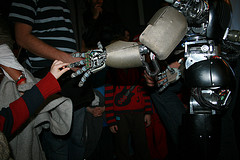|
|
|
Archive for November, 2013
Thursday, November 14th, 2013
 Parallels are constantly drawn between business and sports—building and motivating teams, leading in all its many guises and, of course, the importance and power of stars—whether first round draft choice or coder from the hot startup. Parallels are constantly drawn between business and sports—building and motivating teams, leading in all its many guises and, of course, the importance and power of stars—whether first round draft choice or coder from the hot startup.
I am not a believer in stars and have written numerous times on why they are a bad idea.
I frequently told I’m wrong, especially sports-wise; I’m told that every winning team has stars or they wouldn’t be winning
Not true and thanks to Craig Bohl, North Dakota State’s football coach, I have someone to point who has a very winning team sans stars.
Since 2011, the Bison have posted Division I’s best winning percentage (36-2, .947), slightly ahead of Alabama (33-2, .943) and Oregon (32-3, .914). N.D.S.U. has beaten four Football Bowl Subdivision opponents in four years, most recently the defending Big 12 champion, Kansas State, in this season’s opener on Aug. 30, and is 7-3 against F.B.S. teams since 2006.
Bohl’s understands that with the right attitude and hard work he can build his own star team.
“A lot of our guys come from the farm or hard-working backgrounds, and we’ve leveraged that as we’ve developed our football team. It goes a little counterculture to the way college football is now, with spreads, up-tempo offenses and all those other things. We’ve taken a blue-collar approach on playing hard-nosed, physical, disciplined football, great defense, controlling the football. That’s how we’ve won.”
He’s pragmatic; he doesn’t believe his winners have to walk on water; they just need to be damn good.
“I don’t think there’s a team in the country that would absolutely destroy us, 70-0, or anything like that. Obviously, there are teams that have more talent than we do. I won’t deny that either. But I think we could hold our own with a lot of teams out there.”
Bohl’s approach isn’t rocket science, other than few other coaches want to bother building a team this way or prefer splashier players whose glory can provide a halo effect for coaches and teammates alike.
While Bohl qualifies as a star, and there is constant talk about who will lure him away, he doesn’t seem to be interested.
And he stays for the same reason talented employees always stay.
“When you find a place that fits your value system, the allure of ‘what the big time is’ is not such a big hook.”
Image credit: Ilco
Posted in Entrepreneurs, Motivation, Retention | No Comments »
Wednesday, November 13th, 2013

In a Halloween discussion With KG Charles-Harris (you should read it if you haven’t already) we talked about the possibilities of robots becoming self-willed. I said that might be an improvement over humans, but KG had a different take and it’s been stuck in my mind.
“True, but unfortunately children often absorb some of the worst traits of their parents…”
What bothers me is I don’t think that it’s true anymore for several reasons.
- Children absorb traits and values from their parents/family, but they are just as likely to absorb them from the media and even more likely these days to draw them from their peers.
- Kids may parrot their parents when young, but tend to move in their own direction more and more as they age and grow.
Although I know what KG means when he says “worst,” it is still a word with fluid meaning that is often dependent on one’s own values and beliefs.
This fluidity is particularly noticeable when looking at highly charged subjects, such as politics or religion, where one person’s theme is another’s anathema.
I’m also don’t really agree with Chris’ comment that the worst human trait is greed; another word whose meaning is not always what as expected.
Perhaps I’m too much of an optimist, but if (when?) robots do gain sentience I don’t see them moving in lockstep or necessarily following in our footsteps.
That hasn’t happened even with human generations, e.g., I doubt the Silent Generation saw their values reflected in the Boomers.
Actually, I think sentience, i.e, self-awareness, is a guarantee that there will be no more uniformity in a race of robots than there is in the human race.
Flickr image credit: jepoirrier
Posted in Culture, Ethics | 2 Comments »
Tuesday, November 12th, 2013
 Matt Mullenweg, founder/CEO of Automattic and creator of WordPress, runs a company valued at a billion dollars with a 190 employees who mostly work from home. Matt Mullenweg, founder/CEO of Automattic and creator of WordPress, runs a company valued at a billion dollars with a 190 employees who mostly work from home.
While he doesn’t believe there is one silver bullet that creates great culture, he does have an overarching belief that is easy for any boss with the correctly corresponding MAP to appropriate.
“It’s hard to reduce it down to one thing, but I think regardless of what tools you use to communicate if you give people autonomy to execute on something meaningful, and bias the environment to moving quickly, amazing things can happen.”
Unless you live on a different planet or alternative reality you will have heard that Twitter went public. Biz Stone is Twitter’s co-founder and says his most important lessons came from places he failed.
Such as Xanga…
“The lesson I learned was that company culture at the beginning is incredibly important. You have to tend to it…almost as much as you tend to your product.”
And then there’s Google.
“Google had its list ordered: Technology. People. I think the right order is: People. Technology. You have to think about people first and technology second.”
People. Culture.
Or you can look at it this way, people = culture.
Culture isn’t reality.
There can be no overall reality, because each person’s reality reflects back the sum total of their experiences from cradle to present.
The result is that culture needs a firm, but gentle, hand on the rudder and constant, consistent, intelligent course correction.
The most brilliant technology now or in the future can’t do that.
As long as there’s a human race perceptions between individuals will not be uniform.
Nope, not even the much-vaunted hyper-connectivity can come close to creating a true hive mind.
And I’m even willing to bet that if humans are supplanted by robots, as discussed here on Halloween, uniformity still won’t happen.
Flickr image credit: Josh Gee Photography
Posted in Compensation, Culture | No Comments »
Monday, November 11th, 2013

Oops; Wally Bock’s at it again; much to the detriment of a majority of the leadership industry who aren’t into DIY.
Wally once again put the ball firmly back in management’s court when it comes to engagement.
He did that with an irreverent (gently sarcastic?) take on the ills that engagement is supposed to cure and explaining five engaging actions that bosses at any/every level can and should take.
Wally is a gentleman and far more subtle than I, so he refrained from the blunt assessment I recently gave a client after recommending a similar program.
When “Richard” balked at the personal effort involved and excused his reluctance by saying he would rather “bring in professionals to formulate and implement a strong engagement program” I couldn’t stop laughing.
Richard was offended and we, as my 90 year-old maiden aunt used to say, had words.
The upshot was that I suggested Richard do two things,
- find a coach who wasn’t into DIY and had a comprehensive list of consultants to recommend; and
- update his resume now, since, based on his team’s productivity, creativity and turnover, he would be needing it sooner rather than later.
Flickr image credit: Wendy
Posted in Leadership, Personal Growth | No Comments »
Friday, November 8th, 2013
A Friday series exploring Startups and the people who make them go. Read all If the Shoe Fits posts here
 KG Charles-Harris, EMANIO founder/CEO, sent me a link about GitHub’s lean, “DIY management strategy pulled from the open-source world” and asked me what I thought. KG Charles-Harris, EMANIO founder/CEO, sent me a link about GitHub’s lean, “DIY management strategy pulled from the open-source world” and asked me what I thought.
So I read the article.
Open source lends itself to a great culture with a few caveats.
- All of the approaches and actions described are based on 100% superlative, open, honest, direct, no-game communications, with no exceptions, which aren’t typical of the human race.
- Millennials are impatient and will vote more quickly with their feet; HOWEVER, that may change as they marry and take on mortgages, kids, etc. High risk is more acceptable when you have little to lose.
- The larger/faster a company grows the more difficult to keep hiring for cultural fit; and
- the more difficult it is to keep the micro cultures that form under each leader (whether manager or not) aligned.
There is an underlying problem with stories about cultures like GitHub’s even with in-depth explanations of how and why they work.
Too often, founders who crave the results will try to implement the strategy without taking time to lay the groundwork.
Without the right cultural MAP (mindset, attitude, philosophy™) in place, a deep understanding of their own MAP and a good hiring process that ensures cultural fit, the results will probably be disappointing.
Image credit: Hiking Artist
Posted in Innovation | No Comments »
Thursday, November 7th, 2013
 Earlier this year I cited a study that demonstrates the value of experience for entrepreneurs, something in short supply if you are a twentysomething starting a company in your dorm room. Earlier this year I cited a study that demonstrates the value of experience for entrepreneurs, something in short supply if you are a twentysomething starting a company in your dorm room.
Best of all, there’s no upper end to creativity or sources of inspiration.
Mary Hunter says her ideas com from God, as do her recipes, but it was diabetes that drove her to find a better way to add flavor to the large roasts she cooks for her church.
And it was moxie that kept her moving forward for twenty years, because, whether your idea is the result of heavenly inspiration or drowning frustration in a few beers, execution is never smooth.
Now it’s finally happening.
Later this month, Mary’s Marinating Sticks are scheduled to go on sale in Target stores.
It took enormous risk, Hunter mortgaged her home at age 63; great support from family and friends; a sales force recruited from her church (a la Sarah Breedlove, AKA Madame C. J. Walker), the kind of hard work that generates good luck and a belief strong enough to overcome everything that went wrong—and plenty did.
There are dozens of entrepreneurs who are held up as examples of perseverance in the face of adversity, but few fought it through for 20 years.
Those that fight and win all have one thing in common; an edge of some kind.
Hunter would tell you her edge was God, others would say it was a spouse or friend or just plain stubbornness.
But I think they are more like the Energizer bunny and just keep going and going and going.
Flickr image credit: The Accent
Posted in Entrepreneurs, Innovation | No Comments »
Wednesday, November 6th, 2013

Every so often I come across an old post that is to strong and relevant I feel the need to repost it as opposed to just sharing a link.
Why ‘Cracked Pots’ are Good For Your Team is such a post.
Do you have the courage to hire people with quirks? Those who are unconventional or have unconventional experience for the position? Will you hire someone who is flawed in some way?
Would you hire a ‘cracked pot’ for your team?
An elderly Chinese woman had two large pots, each hung on the ends of a pole which she carried across her neck.
One of the pots had a crack in it while the other pot was perfect and always delivered a full portion of water.
At the end of the long walks from the stream to the house, the cracked pot arrived only half full.
For a full two years this went on daily, with the woman bringing home only one and a half pots of water.
Of course, the perfect pot was proud of its accomplishments.
But the poor cracked pot was ashamed of its own imperfection, and miserable that it could only do half of what it had been made to do.
After two years of what it perceived to be bitter failure, it spoke to the woman one day by the stream.
“I am ashamed of myself, because this crack in my side causes water to leak out all the way back to your house”‘
The old woman smiled, “Did you notice that there are flowers on your side of the path, but not on the other pot’s side?”
“That’s because I have always known about your flaw, so I planted flower seeds on your side of the path, and every day while we walk back, you water them.
For two years I have been able to pick these beautiful flowers to decorate the table.
Without you being just the way you are, there would not be this beauty to grace the house.”
Managed correctly, appreciated instead of tolerated or, worse, homogenized, the idiosyncrasies of your team, the unusual backgrounds, your cracked pots, are what push productivity, juice creativity and drive innovation across the board.
And often it’s another’s management failure that gives you the opportunity to increase the strength of your team.
So cherish the pots you already have and never hesitate to hire another.
Flickr image credit: Blind Grasshopper
Posted in Business info | 2 Comments »
Tuesday, November 5th, 2013

Surprise Industries is founded on an interesting mission.
The idea is to help these companies create silly and weird, but professional cultures where people aren’t afraid to make mistakes, Luna says.
Their focus is tech firms, such as Google, Etsy, and Bit.ly, where most of the management already understands that mistakes are a sign of success, not failure—i.e., nothing ventured nothing gained.
Managers at any level can add elements of surprise to their microculture to draw people out of their comfort zone and open them to more creativity.
But first you need to evaluate your current culture (and yourself) knowing that surprises won’t work under any manager (you) where failure hurts advancement opportunity or the messenger is killed.
Flickr image credit: Simon Cocks
Posted in Culture, Ducks In A Row | No Comments »
Monday, November 4th, 2013
 It’s the same whether in business or athletics. It’s the same whether in business or athletics.
Call it habit or tradition, when a new boss takes over she’s likely to bring in her own team.
This is especially true when the new boss is there to turn things around.
Common wisdom says the boss needs people who are loyal and know how she works.
But when Urban Meyer was brought in as head coach to turn Ohio State around he changed the standard game—and he’d started long before he got the offer.
Meyer figured he would eventually coach again, and he knew that his next head coaching job, his fourth, would be different. His staff would not be stocked with loyal assistants who understood the Meyer Way and its demands. (…) He wanted coaches with local ties, who understood the tradition at Ohio State. He also paid attention to the coaches’ wives. He had seen others “create conflict in our programs.”
Instead, he worked on a list and identified the people he wanted for his new team—relative unknowns as opposed to highly paid stars—and it worked.
To that end, he hurriedly assembled a group of relative strangers when he took over at Ohio State and then kept the group intact for a second season. Together, they have won 19 straight games, their next challenge coming Saturday against Penn State.
I hope you take time to read the story about this boss who brought in disparate people with disparate backgrounds, shared his vision and approach in detail, worked especially hard on strengthening the culture and avoiding previous mistakes.
Because, so far, all the stakeholders are winning.
Flickr image credit: Nina Matthews
Posted in Business info, Innovation, Personal Growth | No Comments »
Friday, November 1st, 2013
A Friday series exploring Startups and the people who make them go. Read all If the Shoe Fits posts here
 The last founder who asked me how to build a stronger creative culture seemed to find it naïve and hilarious when I suggested he admit his errors, show some vulnerability and stop trying to convince his team and investors that he was infallible. The last founder who asked me how to build a stronger creative culture seemed to find it naïve and hilarious when I suggested he admit his errors, show some vulnerability and stop trying to convince his team and investors that he was infallible.
And it’s not the first time I’ve gotten that reaction.
So in the interests of helping founders who prefer to act invulnerable and stand on their dignity I thought I’d share the comments of Neil Blumenthal, co-chief executive of Warby Parker.
It’s through vulnerability that human beings create connections. The more vulnerable we can be with one another, the more that we’ll trust one another and the more we’ll be able to collaborate effectively.
How do you create a culture of innovation? The first way is actually asking for innovation. A lot of companies don’t expect or ask their team members to come up with ideas, but we demand it. It’s just everybody’s responsibility.
One other thing comment from Blumenthal that’s worth remembering…

I think that covers everything and from a source with unarguable credibility.
Flickr image credit: Hiking Artist and Alexander Johnmann
Posted in Culture, If the Shoe Fits, Innovation | No Comments »
|
 Subscribe to
Subscribe to
MAPping Company Success
About Miki 
Clarify your exec summary, website, etc.
Have a quick question or just want to chat? Feel free to write or call me at 360.335.8054
The 12 Ingredients of a Fillable Req
CheatSheet for InterviewERS
CheatSheet for InterviewEEs™
Give your mind a rest. Here are 4 quick ways to get rid of kinks, break a logjam or juice your creativity!
Creative mousing
Bubblewrap!
Animal innovation
Brain teaser
The latest disaster is here at home; donate to the East Coast recovery efforts now!
Text REDCROSS to 90999 to make a $10 donation or call 00.733.2767. $10 really really does make a difference and you'll never miss it.
And always donate what you can whenever you can
The following accept cash and in-kind donations: Doctors Without Borders, UNICEF, Red Cross, World Food Program, Save the Children
*/
?>About Miki
About KG
Clarify your exec summary, website, marketing collateral, etc.
Have a question or just want to chat @ no cost? Feel free to write
Download useful assistance now.
Entrepreneurs face difficulties that are hard for most people to imagine, let alone understand. You can find anonymous help and connections that do understand at 7 cups of tea.
Crises never end.
$10 really does make a difference and you’ll never miss it,
while $10 a month has exponential power.
Always donate what you can whenever you can.
The following accept cash and in-kind donations:
|
 Parallels are constantly drawn between business and sports—building and motivating teams, leading in all its many guises and, of course, the importance and power of stars—whether first round draft choice or coder from the hot startup.
Parallels are constantly drawn between business and sports—building and motivating teams, leading in all its many guises and, of course, the importance and power of stars—whether first round draft choice or coder from the hot startup.




 Matt Mullenweg, founder/CEO of Automattic and creator of WordPress, runs a company valued at a billion dollars with a 190 employees who mostly work from home.
Matt Mullenweg, founder/CEO of Automattic and creator of WordPress, runs a company valued at a billion dollars with a 190 employees who mostly work from home.
 KG Charles-Harris,
KG Charles-Harris,  Earlier this year I cited a study that demonstrates
Earlier this year I cited a study that demonstrates 

 It’s the same whether in business or athletics.
It’s the same whether in business or athletics. The last founder who asked me how to build a stronger creative culture seemed to find it naïve and hilarious when I suggested he admit his errors, show some vulnerability and stop trying to convince his team and investors that he was infallible.
The last founder who asked me how to build a stronger creative culture seemed to find it naïve and hilarious when I suggested he admit his errors, show some vulnerability and stop trying to convince his team and investors that he was infallible.

